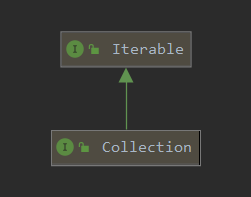Collection开头的注释
看了英文注释,总结以下几点:
①这个接口通常用于传递集合 和 在需要最大通用性时操纵它们。
This interface is typically used to pass collections around and manipulate them where maximum generality is desired.
②所有general-purpose集合实现类应该提供两个标准的构造方法,
一个是 a void(no arguement) constructor which creates an empty collection,一个是 a constructor with a single argument of type Collection ,这个构造器很有用:allows the user to copy any collection, producing an equivalent collection of the desired implementation type,
③ 剩下的以后再翻译,有点搞不懂。
Collection结构

Collection继承了Iterable接口,Iterable接口上写着
Implementing this interface allows an object to be the target of
the "for-each loop" statement
大概意思: 实现这个接口可以让一个对象做循环操作
然后 Iterable接口有一个方法 forEach ,其他的就不展开说了。
add
boolean add(E e);
通过读jdk里的英文注释,总结了以下几点:
① 返回true:如果这个集合的数据因为这次add()方法的调用而改变。
②返回false:如果这个集合不允许重复数据,而调用这个方法时集合中已经有 the specified element(指定元素) 了
③支持该方法的集合可以对被添加的元素作一些限制,比如不允许添加null,或者对被添加元素的type限制。然后这些集合类要在文档中写清楚这些限制。
④如果一个集合拒绝添加the specified element ,并且拒绝的原因不是重复数据的原因,则必须抛出一个异常。
⑤ 为什么要像④这样抛出异常呢? 因为这样可以保证集合中一定能包含the specified element 在 call returns 后。 如下是原句:
This preserves the invariant that a collection always contains the specified element after this call returns.
然后注释中还有一些抛出的异常就不写了,自己去jdk里看。
remove
boolean remove(Object o);
没什么好说的,如果执行完后改变了该集合,那么返回true。
containsAll
boolean containsAll(Collection<?> c);
Returns true if this collection contains all of the elements in the specified collection.
很简单一段注释,如果这个集合包含指定集合(specified collection)的元素,则返回true.
addAll
boolean addAll(Collection<? extends E> c);
当操作进行时,如果指定集合被改变了,那么 The behavior of this operation is undefined(我也不知道什么意思,猜测是“操作失败”)。
同样也是如果该集合因为调用而发生改变,则返回true。
removeAll
boolean removeAll(Collection<?> c);
调用完成后,该集合中不会有和指定集合一样的元素。
removeIf
default boolean removeIf(Predicate<? super E> filter) {
Objects.requireNonNull(filter);
boolean removed = false;
final Iterator<E> each = iterator();
while (each.hasNext()) {
if (filter.test(each.next())) {
each.remove();
removed = true;
}
}
return removed;
}
如果有元素被删除,则返回true(发现没有,和上面一样,也是如果集合发生改变则返回true)
Predicate
Predicate是一个接口,被@FunctionalInterface修饰,所以是一个函数式接口,可以使用lambda表达式。
里面有一些default方法先不管,关键点是test方法
/**
* Evaluates this predicate on the given argument.
*
* @param t the input argument
* @return {@code true} if the input argument matches the predicate,
* otherwise {@code false}
*/
boolean test(T t);
如果return true则将这个元素删除。
第一种写法
collection.removeIf(new Predicate<Student>() {
@Override
public boolean test(Student s) {
return s.getAge()>=20;//过滤20岁以上的学生
}
});
第二种写法
collection.removeIf(
s -> s.getAge() >= 30
);//过滤20岁以上的学生
containsAll
boolean retainAll(Collection<?> c);
相当于取交集






















 246
246











 被折叠的 条评论
为什么被折叠?
被折叠的 条评论
为什么被折叠?








